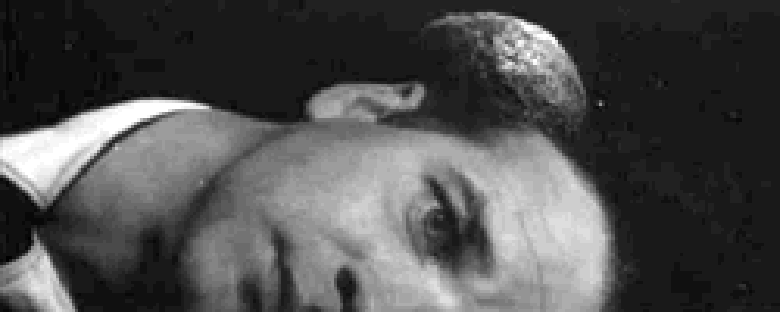Reviews
To mind the single most frightening image in film is the baby in David Lynch’s Eraserhead. The thing, grotesquely deformed, bears no direct human characteristic aside from its persistent cry. Its head, roughly the size of a fist, sports two spotty eyes on either side. Its limbless body contained in a mummified wrap.
This “child” is the progeny of reluctant parents Henry and Mary. The two share not one exchange without displaying some obvious fear of what they have produced. This baby is the horrid manifestation of the fear of parental responsibility; it is embarrassingly hideous and difficult to care for.
The title Eraserhead is a literal reference to a scene late in the film in which Henry’s head falls off. It is surrounded by a pool of blood and it falls through an unseen hole. It lands on a day-lit street, a boy picks it up, sells it to a clerk at a factory that fashions and attaches erasers onto pencils. Henry’s head is drilled into, the offshoot is made into an eraser, hence, eraser-head. Attempting to reason this sort of logic is somewhat futile. In this dark nightmare literalism is as unlikely as a light that doesn’t flicker.
Lynch’s work, (particularly this, Lost Highway and Mulholland Drive) is often described as dream-like or nightmarish, being that his films incorporate a logic best understood in the context of a dream. In truth there is no other way, really, in the vein of traditional criticism to describe it. Eraserhead is a film that seems to require interpretation. Answers, however, are so distant that one wonders if they are even intended.
Of the three cited films Eraserhead is the one that sports a noticeable narrative closure. Though the film’s narrative is evident, the progression from the film’s opening to ending is heedlessly meandering in its direction. Unlike Lynch’s later efforts, the metaphoric quality in Eraserhead is not only implied but apparent.
Consider the opening: Henry’s head is seen superimposed over a spherical rock. Inside the stone is a man staring out a window. The man pulls a lever; a worm is dispelled from inside Henry. This bombardment of unswallowable imagery occurs in the film’s first minutes. One may note that no portion of the film occurs in the rubric of filmic convention, nor, for that matter, does it adhere to any discernable formula. And thus this persistent barrage of stark sounds and images become progressively weird.
Ultimately, in a decade known for producing the most sexually subversive and visually unique films in history, Eraserhead is distinguished as one of its most idiosyncratic entries. Eraserhead rivals any work of surrealism.
The film was made with a grant from the American Film Institute, along with donations from family and friends. One famous bit of trivia is that Lynch got a paper route close to the end of filming to secure his budget. Eraserhead was shot deliberately over the course of three years (the film is similarly paced). This level of exacting direction is evident in every minute of the film. When Henry waits in an elevator, it takes exactly thirteen seconds for the device to raise. Likewise, Henry’s apartment number is 26 (thirteen doubled); Mary’s apartment is number 2416 (2+4+1+6=13). Again, the meaning of these symbols is unknown, yet their noticeable frequency suggests that they “mean” something.
Although Eraserhead was legitimately released in 1977, it has come to be known as a perennial midnight movie, airing in sporadic late-night screenings across the globe.
Despite its defiance of interpretation, one motif in Eraserhead remains largely curious. In Henry’s dark apartment is a radiator. Henry will look at it, scratchy, 30s jazz will play, and the face of a woman will appear. She is dressed in all white, and has very large cheeks. This action occurs repeatedly.
Henry eventually finds way to enter the radiator. Once inside he is on a stage, with the woman (credited, simply, as “the lady in the radiator”). She is kind and inviting, yet when Henry attempts to embrace her he is shocked (an action mimicked visually by a flash of white). A theory (not my own) underlines this image, and forces an interpretation of the film.
This lady in the radiator is death. She intrigues Henry because she is a form of escape from his existence. To further secure this claim is her soothing anthem “in heaven everything is fine.”
The film is often described to occur in a post-apocalyptic setting (which is, in effect, a criticism paired with the film’s theme of isolation). The abundant 30s jazz counterbalances Henry’s contemporary parental paranoia. Exposing this dialectic aids not in interpreting the film; it rather serves to illustrate the level of analysis that may be used to do so. Answers in Eraserhead may be entirely obscured, though attempting to solve this or any logic in Lynch’s canon, for that matter, is nearly custom in viewing his films.
We don’t do comments anymore, but you may contact us here or find us on Twitter or Facebook.



